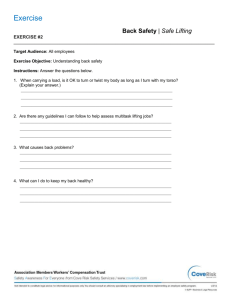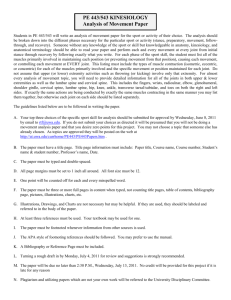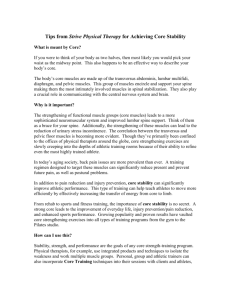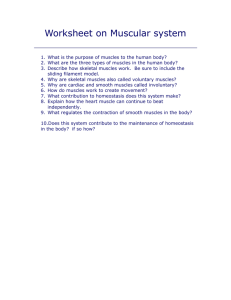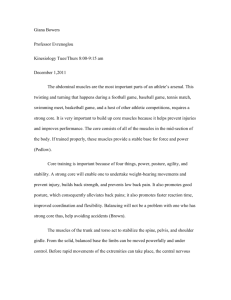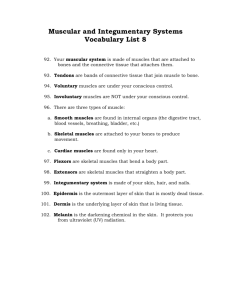A Guide to Maintaining a Healthy Spine
advertisement
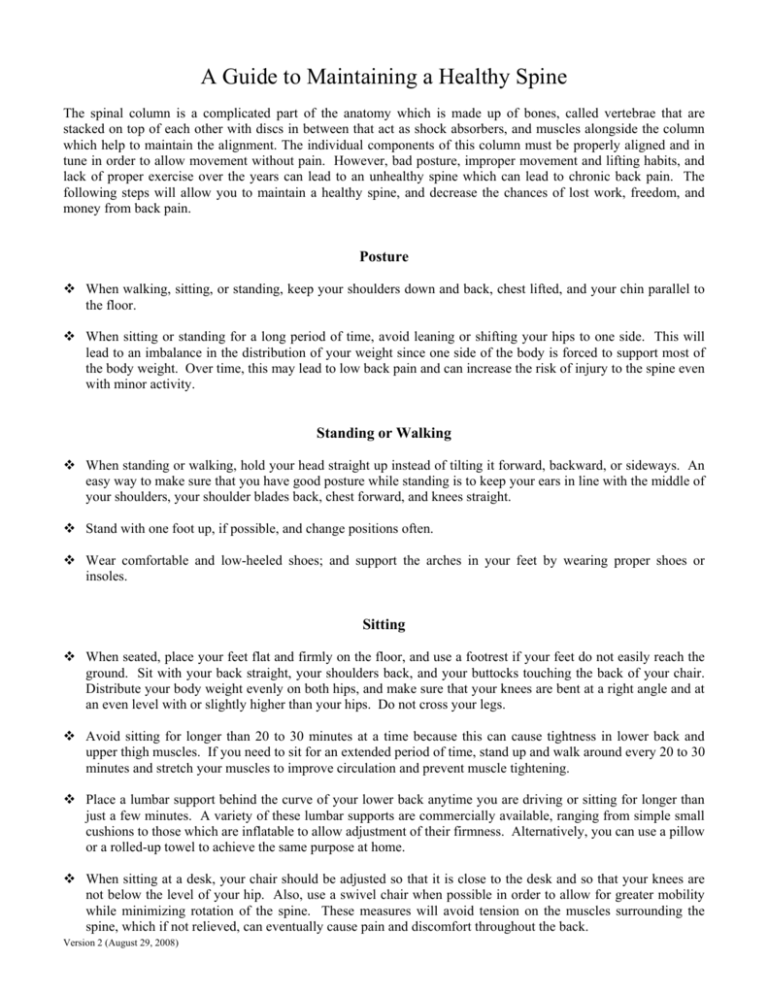
A Guide to Maintaining a Healthy Spine The spinal column is a complicated part of the anatomy which is made up of bones, called vertebrae that are stacked on top of each other with discs in between that act as shock absorbers, and muscles alongside the column which help to maintain the alignment. The individual components of this column must be properly aligned and in tune in order to allow movement without pain. However, bad posture, improper movement and lifting habits, and lack of proper exercise over the years can lead to an unhealthy spine which can lead to chronic back pain. The following steps will allow you to maintain a healthy spine, and decrease the chances of lost work, freedom, and money from back pain. Posture When walking, sitting, or standing, keep your shoulders down and back, chest lifted, and your chin parallel to the floor. When sitting or standing for a long period of time, avoid leaning or shifting your hips to one side. This will lead to an imbalance in the distribution of your weight since one side of the body is forced to support most of the body weight. Over time, this may lead to low back pain and can increase the risk of injury to the spine even with minor activity. Standing or Walking When standing or walking, hold your head straight up instead of tilting it forward, backward, or sideways. An easy way to make sure that you have good posture while standing is to keep your ears in line with the middle of your shoulders, your shoulder blades back, chest forward, and knees straight. Stand with one foot up, if possible, and change positions often. Wear comfortable and low-heeled shoes; and support the arches in your feet by wearing proper shoes or insoles. Sitting When seated, place your feet flat and firmly on the floor, and use a footrest if your feet do not easily reach the ground. Sit with your back straight, your shoulders back, and your buttocks touching the back of your chair. Distribute your body weight evenly on both hips, and make sure that your knees are bent at a right angle and at an even level with or slightly higher than your hips. Do not cross your legs. Avoid sitting for longer than 20 to 30 minutes at a time because this can cause tightness in lower back and upper thigh muscles. If you need to sit for an extended period of time, stand up and walk around every 20 to 30 minutes and stretch your muscles to improve circulation and prevent muscle tightening. Place a lumbar support behind the curve of your lower back anytime you are driving or sitting for longer than just a few minutes. A variety of these lumbar supports are commercially available, ranging from simple small cushions to those which are inflatable to allow adjustment of their firmness. Alternatively, you can use a pillow or a rolled-up towel to achieve the same purpose at home. When sitting at a desk, your chair should be adjusted so that it is close to the desk and so that your knees are not below the level of your hip. Also, use a swivel chair when possible in order to allow for greater mobility while minimizing rotation of the spine. These measures will avoid tension on the muscles surrounding the spine, which if not relieved, can eventually cause pain and discomfort throughout the back. Version 2 (August 29, 2008) Do not reach for objects that are far away from you while in a seated position since this movement beyond the body’s normal range of motion can increase the demand from (and tension on) the back muscles, leading to pain. Instead, stand up or move to a position that allows for easier access. When standing up from the seated position, move to the front of the seat and stand by straightening your legs rather than bending forward at your waist. If you just stood up after sitting for a long time, immediately stretch your back by doing 10 standing backbends. Exercising Exercises such as yoga or tai chi promote back health by keeping your low back muscles strong and balanced to prevent excess strain on the spine. Exercise will also help to reduce stress, which is the source of a great deal of muscle tension that can lead to pain, especially with regard to the spine and its supporting muscles. By managing your stress levels through various means, such as exercise, muscle tension can be reduced, leading to decreased pain and discomfort. Lifting When lifting any object, make sure you have firm footing and stand close to the object that you are trying to lift. Bend from the knees and extend from the hips, tightening your stomach muscles and lifting the object using your leg muscles. Straighten your knees in a steady motion and do not tug the object up to your body. This will recruit the stronger and larger leg muscles (as opposed to the weaker and smaller back muscles) for lifting, which decreases unnecessary tension on the back muscles. Also, by extending from the hips while lifting, the core abdominal and lower back muscles act as an internal belt which support the spine and help to avoid the risk of injuries. Hold objects close to your body and only chest-high, with your arms bent. Keep your stomach muscles tight, take small steps, and go slowly. When turning while holding a large or heavy object, always turn with your feet by taking a few extra steps rather than twisting your back. Twisting your back can easily lead to strain on the muscles around the spine which can put excess strain on the vertebra and cause a tremendous amount of pain and disability. To lower the object, place your feet as you did to lift, tighten your stomach muscles and bend your hips and knees. If you have a choice between pushing or pulling a heavy object, pushing is always better because pulling often requires bending at the waist in order to get leverage, which can increase the load on the spine. Whether pushing or pulling, however, handles should always be high enough so that bending is minimized and both arms should be used to avoid non-symmetric stress on the spine and its surrounding muscles. Driving Driving can be associated with back discomfort for a variety of reasons, including the continuous vibration from the road, need for prolonged sitting, and constant motion of the lower back with stop-and-go driving. To minimize strain on your back from these factors, keep your driving to a minimum. Do not keep your feet suspended in the air while using the pedals – instead, keep your heels on the floor. Version 2 (August 29, 2008) When seated in the car, use a back support (lumbar roll) at the curve of your back, and make sure that your knees are at the same level or slightly lower than the level of your hips. Sit upright and drive with both hands on the steering wheel while keeping your back straight. Avoid extended periods of driving, if possible; and if not, pull over every 20 to 30 minutes to walk around for a few moments and stretch your back. Also, while stopped at the red light and if safe, place the car in PARK mode and apply the parking brakes; and then do gentle stretches to relax your back muscles. Sleeping Sleeping in a curled position can place excess strain on your neck and back muscles; therefore, you should try to lay flat on your back, on your stomach, or in a non-curled position when you sleep. Place a pillow under your knees (if you sleep on your back) or between your legs (if you sleep on your side). Soreness of the back or neck in the morning may be a sign of muscle strain which can be caused by improper alignment of the neck with the rest of the body during sleep. So, make sure you have enough pillows under your head and neck to keep your head in straight alignment with the rest of the body, especially when sleeping on your side. The mattress may also be a source of strain on your back. A mattress that is worn out or too soft will not provide sufficient support for the natural curves of the spine, which can lead to back pain. So, make sure you select a firm mattress and box spring set that is comfortable and firm enough to keep you back and body in alignment. If necessary, place a board under your mattress or place it on the floor to make sure that it does not sag. When standing up from the lying position, do not bend forward at your waist. Instead, turn on your side, and then draw up both knees and swing your legs on the side of the bed. Then, sit by pushing yourself up with your hands. Nouzhan Sehati, MD 13320 Riverside Drive, Suite 208 Sherman Oaks, CA 91423 Phone: (818) 783-4949 Fax: (818) 783-7537 www.sehati.org Version 2 (August 29, 2008)
